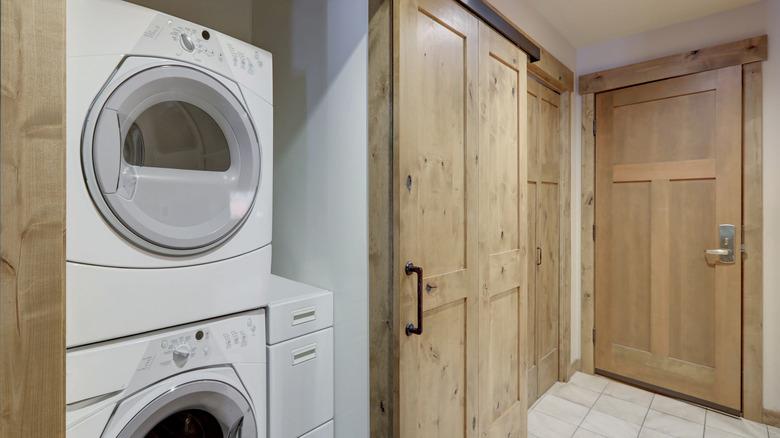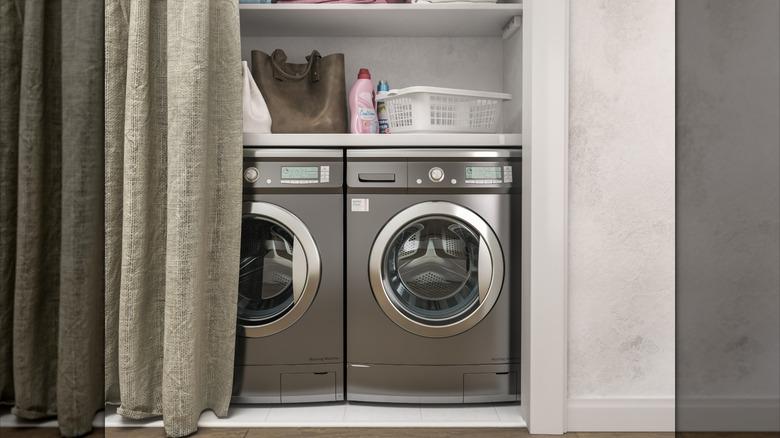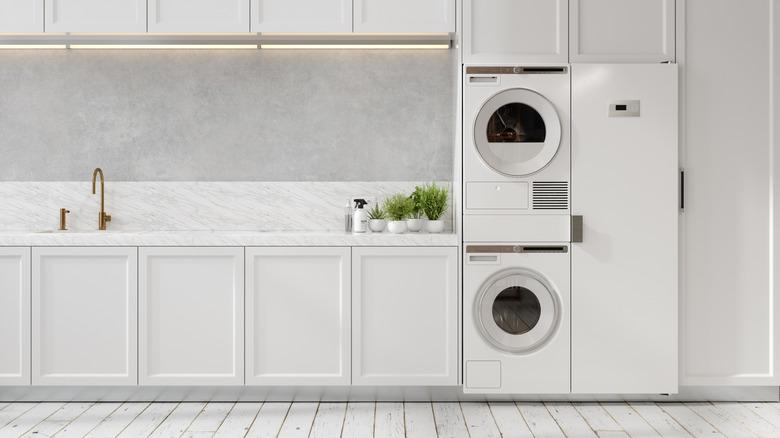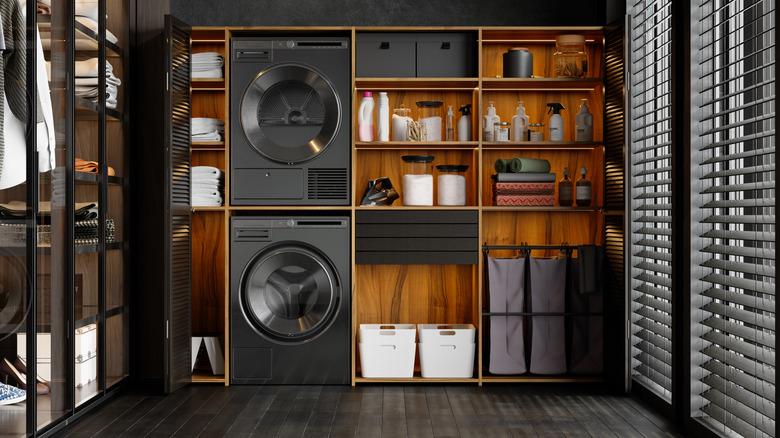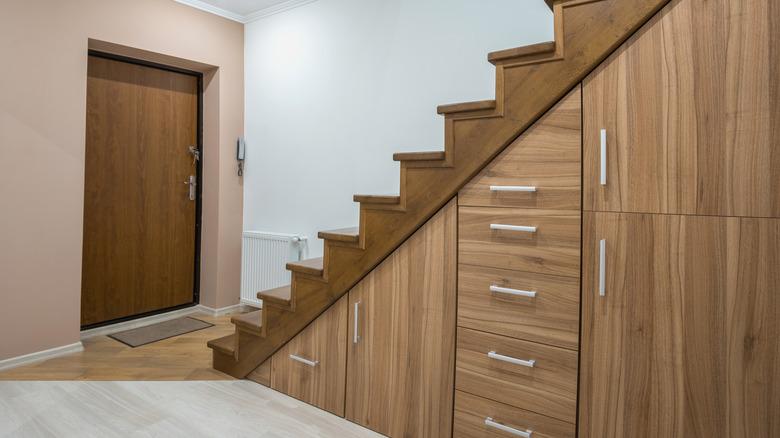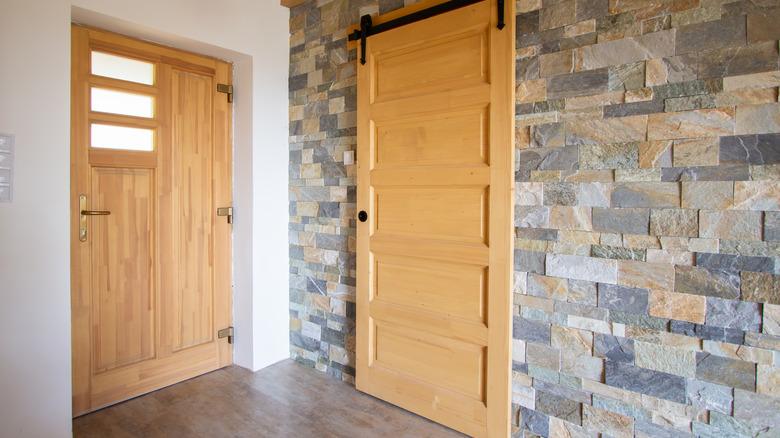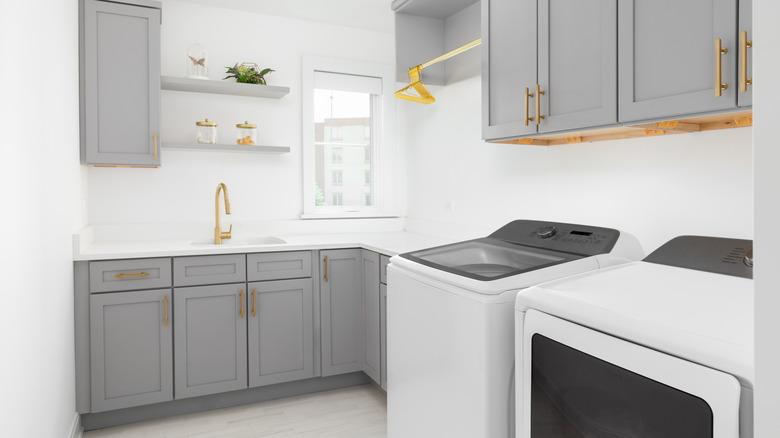7 Stylish Ways To Hide Your Bulky Washer And Dryer
Having your own set of a washer and dryer is a seemingly simple luxury that many people take for granted. As one previous survey from the National Association of Home Builders revealed, having a separate laundry room is an important feature many home buyers are looking for. With that said though, this isn't possible in all homes and regions where space can be on the tighter end. This doesn't mean you have to give up on your dream of having your own laundry appliances, though, especially if you're not planning on selling your home any time soon.
Aside from knowing how to choose a washer and dryer, there are several ways you can hide these bulky appliances. In many cases, you may even be able to work them into your interior design plan. Instead of looking at your washer and dryer as an eyesore, you can get creative with cabinets, doors, and even curtains. One word of caution before you get started: You will need to ensure any area where you store your washer and dryer has proper ventilation, water lines, and either electricity or gas hookups. If you're unsure, it's always a good idea to have a contractor help you with the setup, and then you can get creative with hiding the appliances.
Stack your washer and dryer next to chic cabinetry
If you have a front-loading washer and dryer set, one of the best space-saving techniques is to stack them on top of one another. Setting up your washer and dryer in this way can give the illusion of less bulkiness while also creating more space for nearby cabinets and shelving. Before you stack your washer and dryer on top of one another, it's important to make sure your specific appliances are designed for this setup. Consult the manufacturer or product brochure, if available. The company might also recommend you purchase a stacking kit to help make the units more stable.
Once you have determined you can safely stack your washer and dryer, you can then have fun with installing cabinetry to fit your needs and personal style. Depending on where you install the units, you can place open shelving or closed cabinets directly next to the appliances, or you may even be able to build a cabinet around a stacked washer and dryer in a bathroom. For any open-facing cubbies and shelves, consider adding colorful plastic or neutral baskets to store laundry items. This will enhance the illusion of space and decrease the feeling of clutter.
Conceal a washer and dryer with curtain designs
If you need to maximize the square footage of a smaller home, chances are that your washer and dryer may be within (or directly next to) a common area, such as your kitchen or living room. This doesn't mean your washer and dryer need to be completely out in the open, though. You can still leave these appliances in a high foot traffic area and have some fun with interior design by concealing them with curtains. It turns out that not only is this a practical way to hide a bulky washer and dryer, but curtains can also offer opportunities to add some interesting visual elements within the space.
Aside from design and concealment, this idea is relatively inexpensive. All you need to pull off this look is some fabric and a curtain rod. You can even easily change out the curtain fabric throughout the year to match seasons and holidays. If you need to squeeze the appliances beneath a kitchen island, you can hang the curtains from a countertop, similar to a skirt. Alternatively, if you have a bit more space on the wall above the washer and dryer, you could also consider a full-length curtain to make it appear like there may be a window behind it rather than two appliances.
Place them alongside custom kitchen cabinets
While you can place a washer and dryer in a kitchen and hide them with stylish curtains, this isn't the only way you can blend these appliances into a kitchen setting. Yet another option is to place them behind custom cabinetry. When these appliances are not in use, you can simply close their cabinet doors, and no one will notice they are even there. Not only can building additional cabinets help house the washer and dryer, but doing so may also help to create extra kitchen storage ideas to free up space.
For the best results, make sure the cabinets match the rest of those in your kitchen for a seamless design. Also, if buying additional cabinets is not an option for you currently, you can still help conceal a washer and dryer in the kitchen by helping them blend into your current cabinetry as much as possible. This can be as simple as painting your existing cabinets to match the appliances. Ultimately, this can make your washer and dryer much less noticeable.
Build a freestanding laundry closet
While having a completely separate room or enclosed closet can be helpful for storing a washer and dryer, it's also a misconception that you cannot have these appliances in your home without these entities. In fact, having a freestanding laundry closet is one work-around that appears to be growing in popularity. This works by building floor-to-ceiling cabinetry or shelving in any space that has access to water lines, as well as electricity or gas. What's more, you can build these next to existing cabinetry or shelving to create more of a seamless design.
Another benefit to this option is that it allows you to express your creativity, should you choose to do so. This can involve experimenting with bold colors or designs so that your freestanding laundry closet looks more like a work of art than just a large cabinet. Green is currently a popular cabinet color, as well as other earthy tones, such as brown and blue. Such colors also go along with the current earth luxury décor trends overall. You can potentially go bolder with any other color that works well in the space, however, especially if this is not a permanent structure.
Utilize the area underneath your stairs
If you have a split-level or a two-story home, chances are you may be like a lot of homeowners who have empty spaces underneath their staircases. While you could let this space be free, or turn it into a small office area, you could also potentially use it as a spot to place your washer and dryer. This idea can even work if there is an existing closeted space under your stairs. Alternatively, if the area underneath your stair is completely enclosed, this could still be a potential option for holding your washer and dryer. In this case though, you would need to work with an experienced contractor to remodel the area for holding appliances.
Once you have successfully placed your washer and dryer underneath a staircase, you will then need to consider whether you want the space left open. This could be suitable if the area is not visible from your home's entryway or other vantage points that guests might see. You could, on the other hand, install a door or slider to keep your appliances hidden. The decision ultimately depends on your budget and your personal style.
Cover them with a stylish barn door
Barn doors have had their moment over the last several years, and you may have seen them placed over pantries, living room entryways, offices, and more. The popular barn door can even be used to help close off a space and give the illusion of a separate laundry room while adding a bit of character. This method works particularly well if you have a small closet or closet-like area in your home that is large enough to store a washer and dryer. Rather than having these appliances out in the open though, you can enclose the area with a sliding barn door.
When considering how to install a sliding barn door, the first thing you will need to be mindful of is the metal tracking setup. Unlike other types of doors you might use to hide a washer and dryer, a sliding barn door requires a metal track on the floor. This requires additional space along the wall for the door to be able to slide open without hitting any other shelving, cabinets, or pictures that might be nearby. Home Depot also recommends ensuring that there is about a ½ inch of free space beneath the door, so proper measurements are key here.
When to build a separate laundry room
Despite all of the stylish laundry ideas and inspiration available, it may also be worth looking into building a completely separate laundry room, when applicable. Hiring a professional contractor for your laundry project is essential, particularly if there are no existing gas, electrical, and plumbing lines. All of these types of projects require licensed work. According to Sea Pointe Design & Remodel, the overall cost could be up to $50,000, as the scope of a laundry project is highly individual.
Aside from budget, the decision to build a separate laundry room versus using existing nooks and crannies boils down to your unique home layout and the best ways you can use the space without making it look and feel cramped. Yet another consideration is your home's value. Having a completely separate laundry room may ensure a better resale value in the future, should you ever decide to sell your home. This selling point comes down to what buyers tend to look for in your area, and can be something to consider talking with a real estate professional about if you want to sell sooner rather than later.

